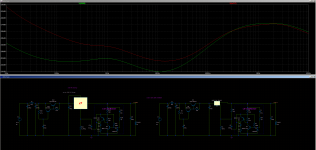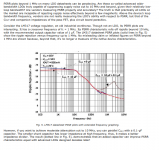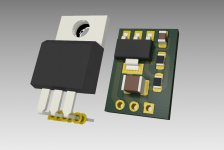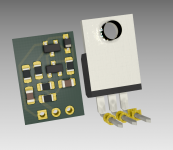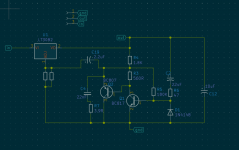The settling time was related to the high 220uF capacitor from dienoiser. For LT3080/LT3082 it needs to be 2.2uF or so and the behavior is normal like a LM317 + dienoiser.
But I need to receive the LT3082 so I can test it and confirm this. But in simulation it looks ok.
There's some advantages to LT3082 being SOT223 and also needing a small ADJ dienoiser cap of 2.2uF means all dienoiser circuit can be 0805 for passives. The 22uF one can be found in 0805 with 16V rating without issues and is not expensive.
But I need to receive the LT3082 so I can test it and confirm this. But in simulation it looks ok.
There's some advantages to LT3082 being SOT223 and also needing a small ADJ dienoiser cap of 2.2uF means all dienoiser circuit can be 0805 for passives. The 22uF one can be found in 0805 with 16V rating without issues and is not expensive.
Looks great thinking of your latest single LM317 board.
They should be the best performing, smallest and cheapest LM3x7 supplies. If anyone knows others (full 1.5A output) that are better performing (theoretically atm) and cheaper and smaller (at the same time) do link them, curious to see them. (edit: and also DIY-able
The inductor should be the most expensive part at around 2$ I think. The 2200uF/35V Panasonic FR should be around 1.5$. I'd also use the LM3x7N versions. I got these as well in TO220 format and will be able to test them. Curious if they have lower noise than the classical LM3x7 versions.
Last edited:
The LT3080 has even more ludicrous PSRR in this configuration, at 1A output (1.1A device).
Not that you'd need that, but curious if it's good for higher frequencies than LM317. I know that LM317 is good up to around 5MHz. Anyone knows if LT3080 goes higher?
I attached the pinout for both LT3080 and LM317, and as you can see even if the LT3080 is a 5pin TO220 device, the pin order matches between them. You'd have to completely cut pin no1 from LT3080, and link 4 with 5. Also LT3080 uses only one voltage setting resistor, so you'd omit the 220R one, and use a 2.2uF coupling cap to dienoiser.
Anyone knows the HF performance difference between the LT3080 and LT1085?
Not that you'd need that, but curious if it's good for higher frequencies than LM317. I know that LM317 is good up to around 5MHz. Anyone knows if LT3080 goes higher?
I attached the pinout for both LT3080 and LM317, and as you can see even if the LT3080 is a 5pin TO220 device, the pin order matches between them. You'd have to completely cut pin no1 from LT3080, and link 4 with 5. Also LT3080 uses only one voltage setting resistor, so you'd omit the 220R one, and use a 2.2uF coupling cap to dienoiser.
Anyone knows the HF performance difference between the LT3080 and LT1085?
Attachments
Last edited:
The BOM cost for the single LM317N supply is about 13$ at Mouser without any resistor as I couldn't be bothered, there's nothing special about either of those. With the recommended inductor, Panasonic FR for all caps, I think I omitted the 100uF output cap as that could be anything under the sun that has around 0.2ohm ESR. You could even pull it from some random pcb. Including all diodes as well as cap multiplier BC550 and MJE15032, and including the dienoiser BJTs and diode/caps.
Last edited:
Not that you'd need that, but curious if it's good for higher frequencies than LM317. I know that LM317 is good up to around 5MHz. Anyone knows if LT3080 goes higher?
You should really start reading the datasheets instead of simulations. Manufacturers tell you to trust their datasheets, not their simulation models. I don't know what you mean by "good up to around 5MHz" but datasheets would tell you that the PSRR drops rapidly after 10kHz for both LM317 and LT3080. The graphs in neither datasheet does not even go beyond 1MHz.
You should really start reading the datasheets instead of simulations. Manufacturers tell you to trust their datasheets, not their simulation models. I don't know what you mean by "good up to around 5MHz" but datasheets would tell you that the PSRR drops rapidly after 10kHz for both LM317 and LT3080. The graphs in neither datasheet does not even go beyond 1MHz.
I remember Elvee mentioning that LM317 doesn't do anything past 5MHz. I was asking someone who tested them at those frequencies.
Trileru,
I always wonder why you still call it LV's Denoiser, when your add-ons are always Dienoiser.
I don't actively do that. It was in one initial spice sim that Elvee or Diego posted, and I just copied the block between the different sim files. I don't actively draw the blue square nor do I actively keep writing "LVs DeNoiser" in each simulation file. And Elvee's Denoiser is contained within the dienoiser circuit that is Diego's spinoff on the original denoiser circuit.
How do you get from "I remember Elvee mentioning that LM317 doesn't do anything past 5MHz" to "I know that LM317 is good up to around 5MHz."???I remember Elvee mentioning that LM317 doesn't do anything past 5MHz. I was asking someone who tested them at those frequencies.
You maybe enthusiastic about these but please stop spreading false information.
please stop spreading false information.
Wouldn't it have been much nicer if you'd also shared some info backing up your claim since we're doing this? We'd all learn something this way. I meant it in general but nice of you to correct this horrendous mistake that might put other people's lives at risk. Stay sharp and watch out for these kinds of mistakes!
Wouldn't it have been much nicer if you'd also shared some info backing up your claim since we're doing this?
Like I said, look at the datasheet. The information is there. Why on earth do you think LM317 or LT3080 would perform drastically better than shown in datasheets?
Using the same logic, the LT108x is a much "slower" regulator than the LM317, as the PSRR graph in their datasheet goes to only 100KHz, while the LM317 graph goes to 1MHz.
We can also deduce that LM317 is just as fast as LT3080. Is that right?
LT3082/LT3088 are much faster than LT3080 since their datasheet PSRR graphs go to 10MHz instead of just 1MHz?
Pretty sure they go a bit further and some people have tested them, hence why I presume Elvee mentioned that LM317 doesn't do anything past 5MHz.
And best guess about the others mentioned here is that we don't know until someone measures them past their datasheet info. They might not do anything, they might do something a bit beyond the graph. Hence why I asked about it, if anybody knows how they behave at higher frequencies.
We can also deduce that LM317 is just as fast as LT3080. Is that right?
LT3082/LT3088 are much faster than LT3080 since their datasheet PSRR graphs go to 10MHz instead of just 1MHz?
Pretty sure they go a bit further and some people have tested them, hence why I presume Elvee mentioned that LM317 doesn't do anything past 5MHz.
And best guess about the others mentioned here is that we don't know until someone measures them past their datasheet info. They might not do anything, they might do something a bit beyond the graph. Hence why I asked about it, if anybody knows how they behave at higher frequencies.
Using the same logic, the LT108x is a much "slower" regulator than the LM317, as the PSRR graph in their datasheet goes to only 100KHz, while the LM317 graph goes to 1MHz.
We can also deduce that LM317 is just as fast as LT3080. Is that right?
LT3082/LT3088 are much faster than LT3080 since their datasheet PSRR graphs go to 10MHz instead of just 1MHz?
Pretty sure they go a bit further and some people have tested them, hence why I presume Elvee mentioned that LM317 doesn't do anything past 5MHz.
And best guess about the others mentioned here is that we don't know until someone measures them past their datasheet info. They might not do anything, they might do something a bit beyond the graph. Hence why I asked about it, if anybody knows how they behave at higher frequencies.
The "logic" you are applying regarding graphs scales is purely your own invention as the scale does not tell anything. Based on the datasheet with regards to PSRR above 1MHz LT3082 should perform clearly better than LM317 or LT3080.
I was asking you if you are certain LT1085 does nothing past 100KHz while LM317 still offers PSRR.
It's one thing to be sure of the specs in the datasheet, another thing to categorically state that the datasheet graph is all there is, and nothing more beyond that point.
It's one thing to be sure of the specs in the datasheet, another thing to categorically state that the datasheet graph is all there is, and nothing more beyond that point.
I was asking you if you are certain LT1085 does nothing past 100KHz while LM317 still offers PSRR.
It's one thing to be sure of the specs in the datasheet, another thing to categorically state that the datasheet graph is all there is, and nothing more beyond that point.
Don't put words in my mouth. I have not made any claims regarding LT1085 nor have I stated that datasheet graph is all there is.
You have categorically stated that I spread false information by stating the LM317 should offer PSRR up to 5MHz, and was curious if you have some measurements refuting what I said.
For example I can offer this in support of my claim:
For example I can offer this in support of my claim:
Attachments
This would also make for a nice option up to 200mA, but first need to check if LT3082 works with dienoiser. Includes the output cap.
Attachments
You have categorically stated that I spread false information by stating the LM317 should offer PSRR up to 5MHz, and was curious if you have some measurements refuting what I said.
For example I can offer this in support of my claim:
It would be better to include a link to the whole article instead of cherry picking. Nice article by the way. Anyhow the extended PSRR shown in that figure is the result of using a smaller shunt capacitor (0.1uF) in parallel with Cadj. LM317 by itself does not have much PSRR above 1MHz contrary to you false claim. However the article also has graphs of a low-noise, high-PSRR RF LDO (the TPS7A47).
- Home
- Amplifiers
- Power Supplies
- D-Noizator: a magic active noise canceller to retrofit & upgrade any 317-based V.Reg.

